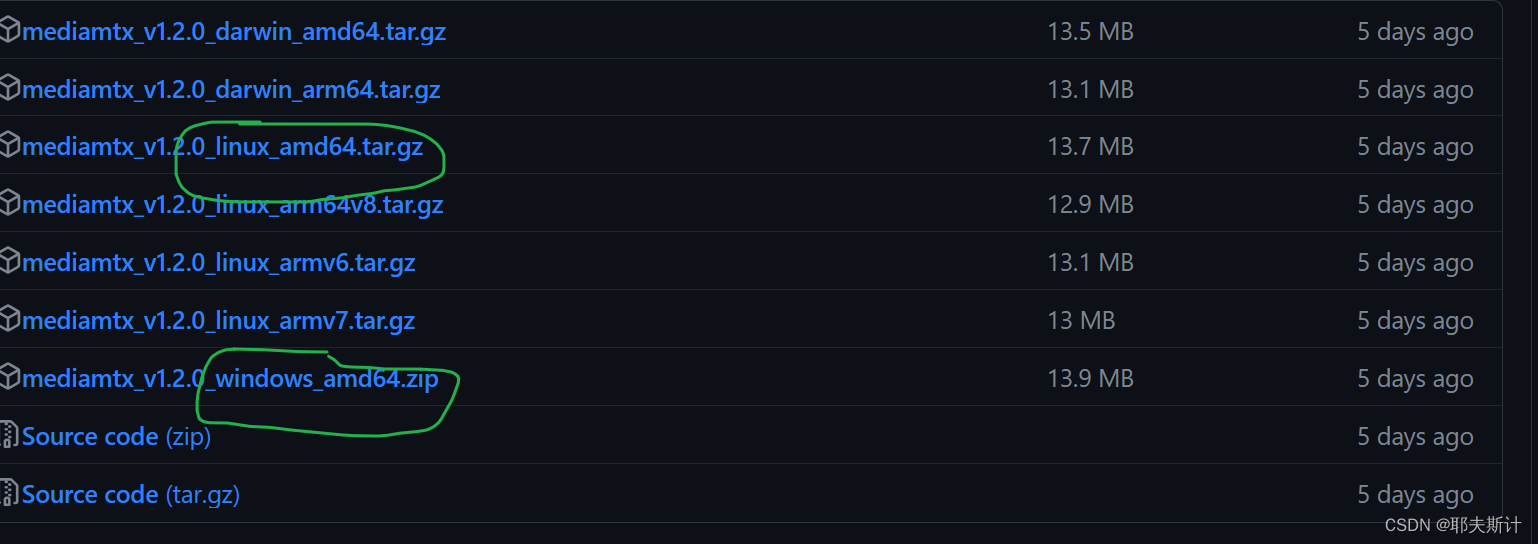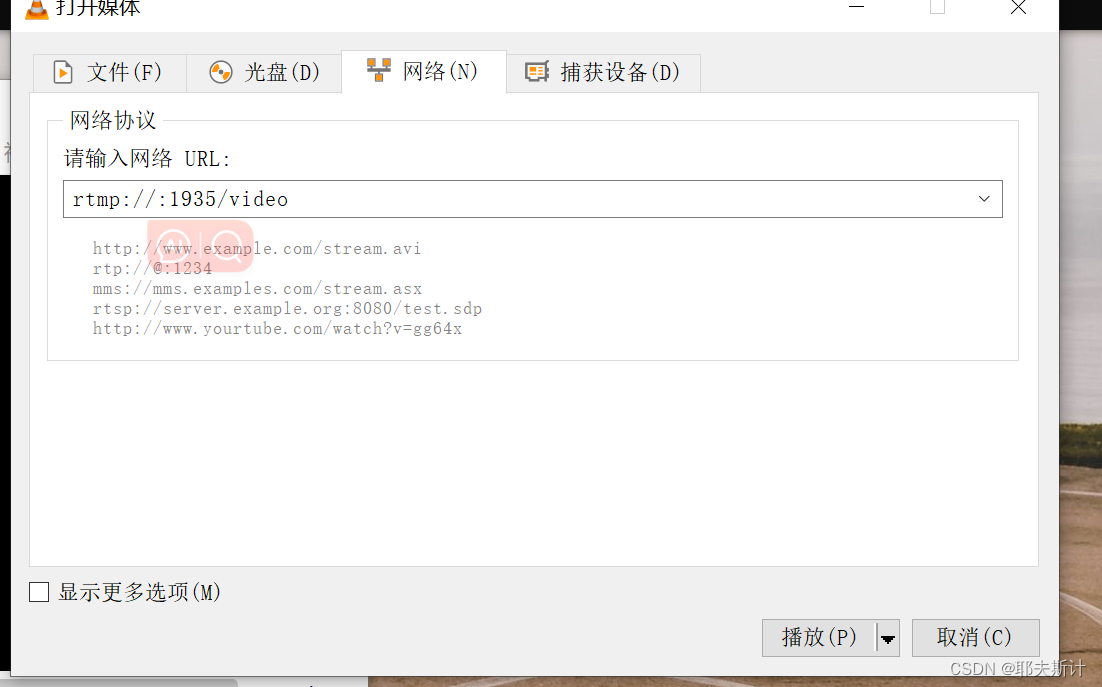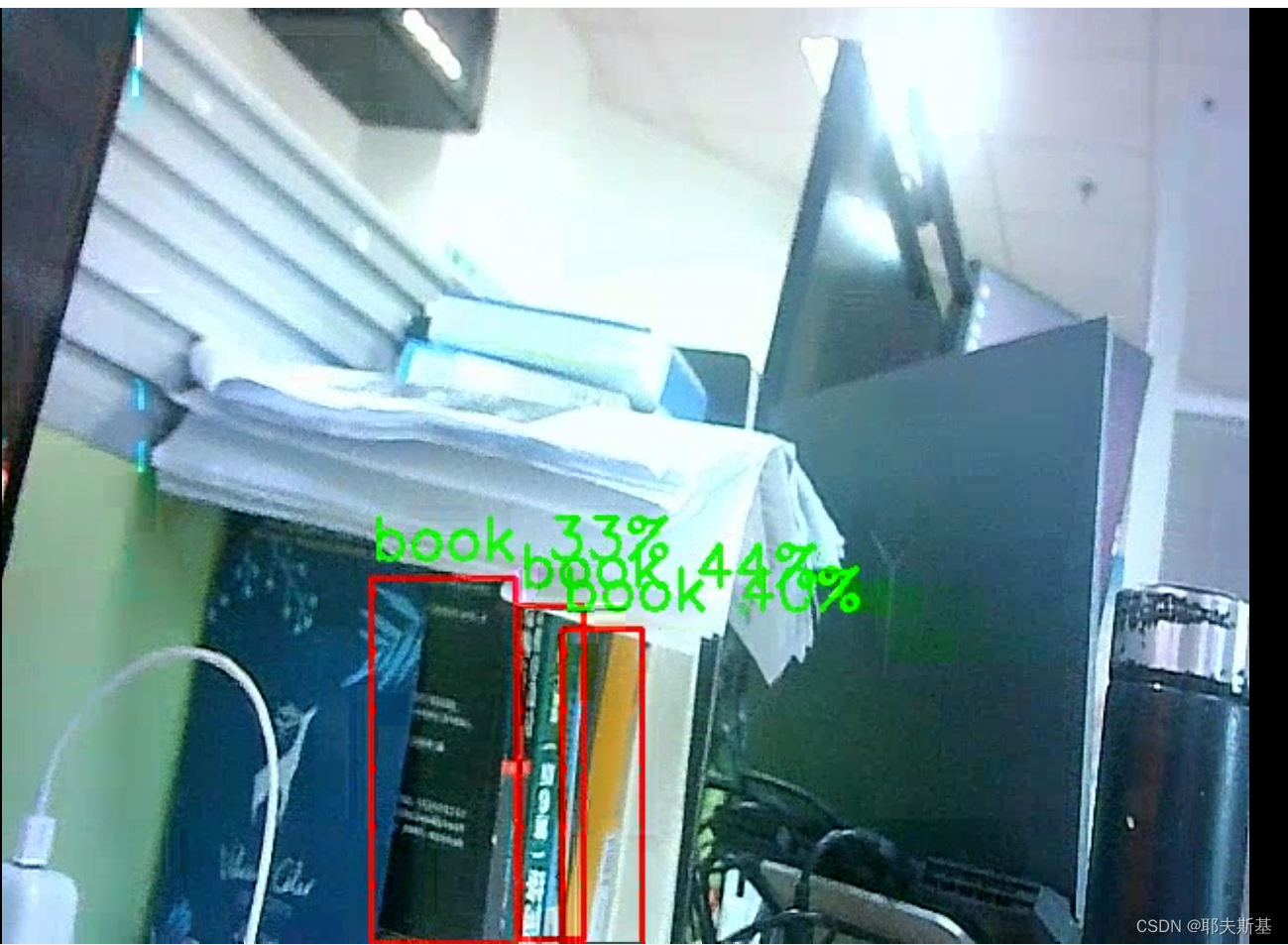热门标签
热门文章
- 1Unity导入资源解决报错_unity导入lighting box 2 lit 报错
- 2java 像素转rgb,如何在Java中将getRGB(x,y)整数像素转换为Color(r,g,b,a)?...
- 3python的线上订餐系统_基于python的网上订餐系统
- 4python如何做到只在服务启动时执行_在后台启动时执行python脚本
- 5iOS MJRefresh上拉加载功能,每次运行下面都会有“上拉加载”这句话,中英文切换?_mjrefresh 选择语言
- 6Kafka集群搭建 (2.11-0.9.0.1)
- 7域名备案、服务器备案和网站备案有什么区别?_服务器备案和域名备案的区别
- 8智能照片修复软件Topaz Video AI mac中文新增功能_topaz video ai mac 中文
- 9【js】ajax加ContentType的方式_js ajax content-type
- 10Python:环境变量配置方法 详细教程_设置python环境变量配置
当前位置: article > 正文
Yolov5、rtsp-server、ffmpeg、vlc,实现实时检测视频推拉流_qgc 验证无人机推流 vlc
作者:Gausst松鼠会 | 2024-02-12 14:51:37
赞
踩
qgc 验证无人机推流 vlc
整体流程:
1.首先现在rtsp-server服务器(如果采用的是虚拟机或者是服务器,可以下载对应的linux服务器),我下载的是图片上的两个版本。下载完毕后直接打开文件夹下的mediamtx.exe
Releases · bluenviron/mediamtx (github.com)

2.在代码中执行main.py函数
- rtmp_server = 'rtmp://你的主机ip:1935/video'
-
- if __name__ == '__main__':
- parser = argparse.ArgumentParser()
- parser.add_argument('--imgpath', type=str, default='video/test.mp4', help="image path")
- parser.add_argument('--modelpath', type=str, default='models/yolov7-tiny_384x640.onnx',
- choices=["models/yolov7_640x640.onnx", "models/yolov7-tiny_640x640.onnx",
- "models/yolov7_736x1280.onnx", "models/yolov7-tiny_384x640.onnx",
- "models/yolov7_480x640.onnx", "models/yolov7_384x640.onnx",
- "models/yolov7-tiny_256x480.onnx", "models/yolov7-tiny_256x320.onnx",
- "models/yolov7_256x320.onnx", "models/yolov7-tiny_256x640.onnx",
- "models/yolov7_256x640.onnx", "models/yolov7-tiny_480x640.onnx",
- "models/yolov7-tiny_736x1280.onnx", "models/yolov7_256x480.onnx"],
- help="onnx filepath")
- parser.add_argument('--confThreshold', default=0.3, type=float, help='class confidence')
- parser.add_argument('--nmsThreshold', default=0.5, type=float, help='nms iou thresh')
- args = parser.parse_args()
-
- # Initialize YOLOv7 object detector
- yolov7_detector = YOLOv7(args.modelpath, conf_thres=args.confThreshold, iou_thres=args.nmsThreshold)
-
- VID_FORMATS = ['asf', 'avi', 'gif', 'm4v', 'mkv', 'mov', 'mp4', 'mpeg', 'mpg', 'wmv'] # include video suffixes
- imgpath = args.imgpath
- print(imgpath.split('.')[-1])
- if imgpath.split('.')[-1] in VID_FORMATS:
- cap = cv2.VideoCapture(0)
- pusher = StreamPusher(rtmp_server)
- while True:
- success, srcimg = cap.read()
- srcimg = imutils.resize(srcimg, width=640)
- t1 = time.time()
- boxes, scores, class_ids = yolov7_detector.detect(srcimg)
- print(time.time() - t1) # 测量处理一帧图像的时间 用于评估模型的处理速度或性能(推理时间)
- # Draw detections
- dstimg = yolov7_detector.draw_detections(srcimg, boxes, scores, class_ids)
- print(time.time() - t1) # 测量了模型的推理时间以及绘制检测结果的时间
- winName = 'Deep learning object detection in OpenCV'
- # cv2.namedWindow(winName, 0)
- # cv2.imshow(winName, dstimg)
-
- cv2.waitKey(1)
- pusher.streamPush(dstimg)
- cv2.destroyAllWindows()
- else:
- srcimg = cv2.imread(args.imgpath)
- # Detect Objects
- t1 = time.time()
- boxes, scores, class_ids = yolov7_detector.detect(srcimg)
- print(time.time() - t1)
- # Draw detections
- dstimg = yolov7_detector.draw_detections(srcimg, boxes, scores, class_ids)
- print(time.time() - t1)
- winName = 'Deep learning object detection in OpenCV'
- cv2.namedWindow(winName, 0)
- cv2.imshow(winName, dstimg)
- cv2.waitKey(0)
- cv2.destroyAllWindows()

3.采用vlc拉流:

4.代码解析
a.定义推流器:我在用的是ffmpeg进行推流,在虚拟环境中使用pip安装ffmpeg包
- class StreamPusher:
- def __init__(self, rtmp_url): #接受一个参数rtmq_url 该参数受用于指定rtmq服务器地址的字符串
- # 创建FFmpeg命令行参数
- ffmpeg_cmd = ['ffmpeg',
- '-y', # 覆盖已存在的文件
- '-f', 'rawvideo', #指定输入格式为原始视频帧数据
- '-pixel_format', 'bgr24', #指定输入数据的像素格式为BGR24(一种图像颜色编码格式)
- '-video_size', '640x480', #指定输入视频的尺寸为640*480
- '-i', '-', # 从标准输入读取数据
- '-c:v', 'libx264', #指定视频编码器为libx264(H.264编码器)
- '-preset', 'ultrafast', #使用ultrafast预设,以获得更快的编码速度
- '-tune', 'zerolatency', #使用zerolatency调整 以降低延迟
- '-pix_fmt', 'yuv420p', #指定输出视频像素格式为yuv420p
- '-f', 'flv', #指定输出格式为FLV
- rtmp_url] #指定输出目标为‘rtmp_url' 即RTMP服务器地址
- print('ffmpeg_cmd:', ffmpeg_cmd)
- # 启动 ffmpeg
- self.ffmepg_process = subprocess.Popen(ffmpeg_cmd, stdin=subprocess.PIPE)
-
- def streamPush(self, frame): #用于推送视频帧数据到FFmpeg进程
- self.ffmepg_process.stdin.write(frame.tobytes())

b.采用onnx格式文件来封装yolo的模型权重文件(可以去github上下载yolo源码生成.onnx文件),因为onnx只是模型和权重文件,其他一些的后处理组件要自己定义,具体如下:
- class YOLOv7:
- def __init__(self, path, conf_thres=0.7, iou_thres=0.5):
- self.conf_threshold = conf_thres
- self.iou_threshold = iou_thres
- self.class_names = list(map(lambda x: x.strip(), open('coco.names', 'r').readlines()))
- # Initialize model
- self.session = onnxruntime.InferenceSession(path, providers=['CUDAExecutionProvider', 'CPUExecutionProvider'])
- model_inputs = self.session.get_inputs()
- self.input_names = [model_inputs[i].name for i in range(len(model_inputs))]
- self.input_shape = model_inputs[0].shape
- self.input_height = self.input_shape[2]
- self.input_width = self.input_shape[3]
-
- model_outputs = self.session.get_outputs()
- self.output_names = [model_outputs[i].name for i in range(len(model_outputs))]
- self.has_postprocess = 'score' in self.output_names
-
- def detect(self, image):
- input_tensor = self.prepare_input(image)
-
- # Perform inference on the image
- outputs = self.session.run(self.output_names, {self.input_names[0]: input_tensor})
-
- if self.has_postprocess:
- boxes, scores, class_ids = self.parse_processed_output(outputs)
-
- else:
- # Process output data
- boxes, scores, class_ids = self.process_output(outputs)
-
- return boxes, scores, class_ids
-
- def prepare_input(self, image):
- self.img_height, self.img_width = image.shape[:2]
-
- input_img = cv2.cvtColor(image, cv2.COLOR_BGR2RGB)
-
- # Resize input image
- input_img = cv2.resize(input_img, (self.input_width, self.input_height))
-
- # Scale input pixel values to 0 to 1
- input_img = input_img / 255.0
- input_img = input_img.transpose(2, 0, 1)
- input_tensor = input_img[np.newaxis, :, :, :].astype(np.float32)
- return input_tensor
-
- def process_output(self, output):
- predictions = np.squeeze(output[0]) #输出一个多维数组
-
- # Filter out object confidence scores below threshold
- obj_conf = predictions[:, 4]
- predictions = predictions[obj_conf > self.conf_threshold]
- obj_conf = obj_conf[obj_conf > self.conf_threshold]
-
- # Multiply class confidence with bounding box confidence
- predictions[:, 5:] *= obj_conf[:, np.newaxis]
-
- # Get the scores
- scores = np.max(predictions[:, 5:], axis=1)
-
- # Filter out the objects with a low score
- valid_scores = scores > self.conf_threshold
- predictions = predictions[valid_scores]
- scores = scores[valid_scores]
-
- # Get the class with the highest confidence
- class_ids = np.argmax(predictions[:, 5:], axis=1)
-
- # Get bounding boxes for each object
- boxes = self.extract_boxes(predictions)
-
- # Apply non-maxima suppression to suppress weak, overlapping bounding boxes
- # indices = nms(boxes, scores, self.iou_threshold)
- nms_indices = cv2.dnn.NMSBoxes(boxes.tolist(), scores.tolist(), self.conf_threshold, self.iou_threshold)
- indices = np.array(nms_indices).flatten().astype(int)
- return boxes[indices], scores[indices], class_ids[indices]
-
- def parse_processed_output(self, outputs):
-
- scores = np.squeeze(outputs[self.output_names.index('score')])
- predictions = outputs[self.output_names.index('batchno_classid_x1y1x2y2')]
-
- # Filter out object scores below threshold
- valid_scores = scores > self.conf_threshold
- predictions = predictions[valid_scores, :]
- scores = scores[valid_scores]
-
- # Extract the boxes and class ids
- # TODO: Separate based on batch number
- batch_number = predictions[:, 0]
- class_ids = predictions[:, 1]
- boxes = predictions[:, 2:]
-
- # In postprocess, the x,y are the y,x
- boxes = boxes[:, [1, 0, 3, 2]]
-
- # Rescale boxes to original image dimensions
- boxes = self.rescale_boxes(boxes)
-
- return boxes, scores, class_ids
-
- def extract_boxes(self, predictions):
- # Extract boxes from predictions
- boxes = predictions[:, :4]
-
- # Scale boxes to original image dimensions
- boxes = self.rescale_boxes(boxes)
-
- # Convert boxes to xywh format
- boxes_ = np.copy(boxes)
- boxes_[..., 0] = boxes[..., 0] - boxes[..., 2] * 0.5
- boxes_[..., 1] = boxes[..., 1] - boxes[..., 3] * 0.5
- return boxes_
-
- def rescale_boxes(self, boxes):
-
- # Rescale boxes to original image dimensions
- input_shape = np.array([self.input_width, self.input_height, self.input_width, self.input_height])
- boxes = np.divide(boxes, input_shape, dtype=np.float32)
- boxes *= np.array([self.img_width, self.img_height, self.img_width, self.img_height])
- return boxes
-
- def draw_detections(self, image, boxes, scores, class_ids):
- for box, score, class_id in zip(boxes, scores, class_ids):
- x, y, w, h = box.astype(int)
-
- # Draw rectangle
- cv2.rectangle(image, (x, y), (x+w, y+h), (0, 0, 255), thickness=2)
- label = self.class_names[class_id]
- label = f'{label} {int(score * 100)}%'
- labelSize, baseLine = cv2.getTextSize(label, cv2.FONT_HERSHEY_SIMPLEX, 0.5, 1)
- # top = max(y1, labelSize[1])
- # cv.rectangle(frame, (left, top - round(1.5 * labelSize[1])), (left + round(1.5 * labelSize[0]), top + baseLine), (255,255,255), cv.FILLED)
- cv2.putText(image, label, (x, y - 10), cv2.FONT_HERSHEY_SIMPLEX, 1, (0, 255, 0), thickness=2)
- return image

3.采用cap = cv2.VideoCapture(0)读取本地摄像头,针对每帧进行目标检测算法然后进行推流:
- if imgpath.split('.')[-1] in VID_FORMATS:
- cap = cv2.VideoCapture("rtmp://:1935/stream")
- pusher = StreamPusher(rtmp_server)
- while True:
- success, srcimg = cap.read()
- srcimg = imutils.resize(srcimg, width=640)
- t1 = time.time()
- boxes, scores, class_ids = yolov7_detector.detect(srcimg)
- print(time.time() - t1) #测量处理一帧图像的时间 用于评估模型的处理速度或新能(推理时间)
- # Draw detections
- dstimg = yolov7_detector.draw_detections(srcimg, boxes, scores, class_ids)
- print(time.time() - t1) #测量了模型的推理时间以及绘制检测结果的时间
- winName = 'Deep learning object detection in OpenCV'
- #cv2.namedWindow(winName, 0)
- #cv2.imshow(winName, dstimg)
-
- cv2.waitKey(1)
- pusher.streamPush(dstimg)
- cv2.destroyAllWindows()
- else:
- srcimg = cv2.imread(args.imgpath)
- # Detect Objects
- t1 = time.time()
- boxes, scores, class_ids = yolov7_detector.detect(srcimg)
- print(time.time() - t1)
- # Draw detections
- dstimg = yolov7_detector.draw_detections(srcimg, boxes, scores, class_ids)
- print(time.time() - t1)
- winName = 'Deep learning object detection in OpenCV'
- cv2.namedWindow(winName, 0)
- cv2.imshow(winName, dstimg)
- cv2.waitKey(0)
- cv2.destroyAllWindows()

效果展示:

以上代码借鉴了很多博主的文章,具体的忘记了。如有冒犯,多多谅解!
代码地址:
GitHub - 23jisuper/yolov7-ffmpeg: 基于yolov5目标检测,使用ffmpeg推流 vlc拉流
后续工作:
目标检测模型采用的是cpu进行推理的,可以采用GPU加速推理。整个代码是根据python实现的,考虑采用C++代替来提高速度。
声明:本文内容由网友自发贡献,转载请注明出处:【wpsshop博客】
推荐阅读
相关标签


